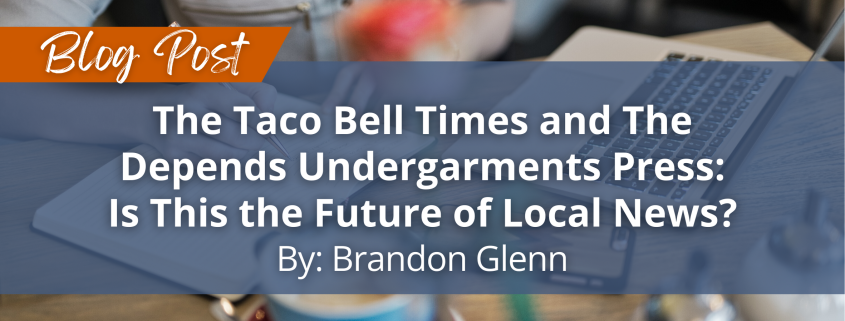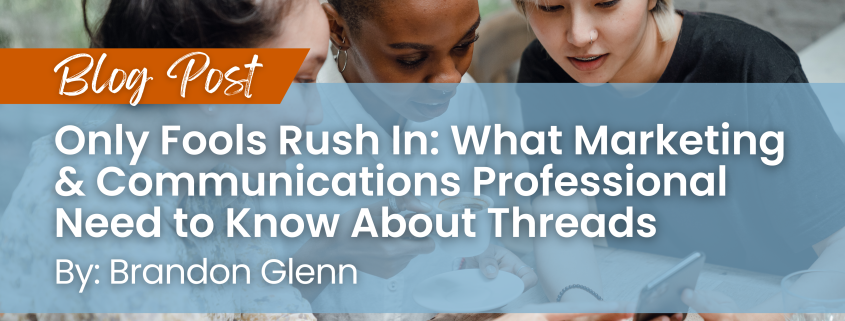
by Brandon Glenn | Aug 7, 2024 | Blog
We all understand that the role of a corporate marketing department, among other things, is to promote its company, educate potential customers, and strengthen the company’s brand image – with the ultimate goal of driving higher sales.
Most marketers know how to articulate the benefits and value proposition of their company’s products, and, generally, they do a solid job of it.
What fewer marketers understand is when NOT to talk about their companies – particularly on social media. (For the purposes of this article, we’ll focus on LinkedIn because it’s the most valuable social site for business users.)
It’s important for marketers to remember that social media platforms are intended to encourage two-way communication, as opposed to functioning like a megaphone used to blast messages.
Accordingly, corporate social media must focus on providing value to followers. Indeed, corporate social media success requires putting followers’ wants and needs above the company’s own objectives.
The 80/20 rule for social media success
The 80/20 rule is the answer for keeping marketers focused on delivering value to their audiences. This cardinal rule for social media simply holds that 80% of the content posted to a social account should deliver value to the audience (think general industry news, opinions, and observations) while it’s ok for the other 20% to be blatantly promotional.
In my experience, most corporate marketing departments have mastered the 20% aspect of the rule but tend to struggle with the 80% part. Admittedly, it can be a little daunting in the beginning to understand and figure out how to fulfill this goal.
First, start with a list of keywords that pertain to your company’s niche in the industry. For example, if the company works in the virtual care space, create news alerts and perform searches for keywords like “telehealth,” “virtual care,” “virtual nursing,” “value-based care,” “healthcare staffing shortages,” and “healthcare burnout,” for example. Relevant hash tags can also help to surface third-party articles that discuss industry trends.
These articles make up the 80% of non-promotional content, while the other 20% can consist of product and technology-related information specific to the company.
Professionals go to LinkedIn when they need information, making it a great place to demonstrate thought leadership by sharing insights, stats, and case studies. These users want to discuss topics in their industry, cultivate professional connections, and better themselves as professionals along their career trajectory.
By adhering to the 80/20 rule, brands can help LinkedIn users accomplish these objectives. Just keep in mind the cardinal rule of social media: It’s not all about you.

by Brandon Glenn | Apr 17, 2024 | Blog
As a dutiful student and practitioner of public relations, corporate communications, and journalism, I have become intimately familiar with AP style – like it or not.
For example, I know that “Wi-Fi” is for some reason capitalized at all times and hyphenated regardless of where it’s used in a sentence.
I know that the word “unique” should never be used with a qualifier. Unique means “one-of-a-kind,” so what is the difference between something that is “very” or “rather” one-of-a-kind vs. something that is simply one-of-a-kind?
I know that Oxford commas are an affront to humanity and must be relegated to the ash heap of history.
Unfortunately, I’ve spent enough time learning, studying, and practicing these rules to wish for several years of my life back. Yet there is one AP style rule I keep coming back to mentally and have never been able to get out of my head since I learned it many years ago.
Who vs. that: Who is it that actually spent time thinking about this?
The best rule in the AP style pertains to the answer to a question that few people have ever dared to ask, and even fewer could bear the weight of fully contemplating: When we are referring to animals, is the appropriate relative pronoun “who” or “that”?
In other words, which is the right choice: “The dog who chased after the car” or “the dog that chased after the car”? “The rhinoceros who is bathing in the river” or “the rhinoceros that is bathing in the river”? (Side note: If I’m interpreting AP style correctly, the question marks in the previous paragraphs should be outside the quotation marks.)
Leave it to those visionary and imaginative AP style editors to come up with an answer that sheds much-needed clarity on an issue that most of us would find too trivial to even ponder: “It depends.”
Yes, it’s true. When confronted with a monumental, mind-blowing question that would affect the course of countless lives and have far-reaching implications for the future of humanity over decades to come, the AP style editors opted to hedge by choosing an answer with a little from column A, and a little from column B.
So, here’s the rule: Animals with names should be referred to as “who,” while animals without names should be referred to as “that” or “which.”
I’m not making this up. People were actually (presumably) paid real, legitimate money to sit around discussing this pressing and contentious issue, and this is what they thought was the best outcome. Alas, how we should refer to animals that/who may or may not have names, such as a stray cat that/who once had a name and guardian but now lives anonymously on the streets, remains frustratingly unclear.
I can’t help but fantasize about being a fly on the wall for the discussions that led to the creation of this rule. I can only hope it was an intense, hours-long discussion in the glass-walled conference room of a sleek urban high rise, with advocates of both sides of the debate having prepared long and detailed slide decks that present their sides of the case in agonizing detail.
I imagine that passions became so heated and rivalries grew so fierce between the “who” side and the “that” side that a couple of the editors nearly came to violent blows as they had to be separated by shocked, fearful colleagues who had underestimated the near-religious fervor such a debate would inspire.
I have a difficult time believing that AP style has ever given us a more unnecessary and largely pointless distinction than the “who” vs. “that” named-animal-rule controversy, but I hold out hope that there are even more obscure, dumber rules to discover as I continue my lifelong AP style learning pursuit.

by Brandon Glenn | Jan 3, 2024 | Blog
The sad state of local news in the U.S. is hardly news to anyone who has spent time in public relations and journalism.
News outlets across the nation are continually going out of business, creating “news deserts” where communities are largely devoid of any reliable sources of credible information.
Though often overlooked, local news outlets can be valuable resources for public relations professionals and their clients. Whether they are general interest dailies, weeklies, or business publications, these media outlets are often interested in milestone topics that don’t necessarily appeal to trade or national media, such as hiring plans, headquarters’ expansions, acquisitions, and other factors that may affect the local economy.
Over the last 15 years, ”the local news crisis has metastasized like a slow-moving cancer coursing through the bloodstream of enclaves from suburbia to rural America,” as a recent report on the state of local news from Northwestern University’s Medill School so eloquently phrased it.
The report is full of stark and sobering numbers and facts. For example:
- The nation has lost one-third of its newspapers and two-thirds of its newspaper journalists since 2005
- An average of 2.5 newspapers closed each week in 2023
- Roughly half of all U.S. counties are now only served with one remaining local news source — typically a weekly newspaper
- Most communities that lose a local newspaper typically do not get a replacement, even online
The decline of local news should be concerning for anyone who cares about democracy, good governance, and public accountability. Why? Studies have shown that the decline in local news has increased political polarization, led to more political corruption, and let outlets that spread misinformation fill the void, the AP reported.
Indeed, this dearth of reliable, community-level information “poses a far-reaching crisis for our democracy as it simultaneously struggles with political polarization, a lack of civic engagement, and the proliferation of misinformation and information online,” the Northwestern report states.
Wealthy corporations to the rescue? What could go wrong?
Against the backdrop of this escalating existential crisis for local news, I was interested to read a proposal by marketing thought leader extraordinaire Joe Pulizzi, founder of the Content Marketing Institute, who suggests that newspapers should follow the model of sports teams selling stadium naming rights to private companies.
Pulizzi throws out the example of his hometown Cleveland Plain Dealer, struggling with a barely there print product and less-than-attractive website, selling its naming rights to local megacorporation Progressive Insurance. Pulizzi notes that Progressive pays $3.6 million a year for the naming rights for the Cleveland Guardians’ stadium, while it spent $1.37 billion on advertising in 2022, so another $3 million to sponsor a newspaper represents the equivalent of loose pocket change for the insurance giant.
It’s an intriguing idea and one that we could see experimented with around the country, though as Pulizzi correctly notes, “A key challenge in making this concept a reality is ensuring mutual expectations are met for the businesses receiving such subsidies.”
Ahh, yes, there’s the potential problem. In other words, what kind of deference might Progressive’s executive suite and board of directors expect from The Progressive Plain Dealer when they object to the tone of its editorial coverage?
Corporate sponsorship would create a minefield of ethical challenges for journalists, the communities that rely on them for information, and corporate executives. If the past is any indication, this will not end well for journalists and their communities.
In my decade or so of experience as a business journalist one thing became abundantly clear: People who have accumulated a substantial amount of wealth, power, and influence will virtually always use that wealth, power, and influence to further their own interests. In a sense, they can’t help themselves. What’s the point of rising to power if you can’t use that power?
So, returning to the Progressive Plain Dealer example, what happens to the outlet’s news coverage when Progressive suffers an embarrassing public relations gaffe? What if the CEO’s country club buddy gets popped for a DUI? What if a political candidate the CEO is personally backing is shown to have used campaign funds to pay hush money to a porn star?
In all these scenarios, and countless others we could imagine if we took the time, I would virtually guarantee you that Progressive would use its funding, and the threat of revoking it, to try to slant the news outlet’s coverage in a way that is more favorable to Progressive’s viewpoint and business interests. The community would sense and suspect this, damaging the Progressive Plain Dealer’s credibility with its readers, and potentially plunging us back into the local news crisis all over again. Alas, cash rules everything around me, as some wise philosophers once reminded us.
Nonetheless, I applaud the creativity in seeking out solutions to the local news dilemma and may soon have little choice but to welcome our new corporate news overlords.

by Brandon Glenn | Aug 30, 2023 | Blog
Now that it looks like the much-anticipated but always-farfetched Elon Musk vs. Mark Zuckerberg cage fight is unlikely to happen, we’ll all have to settle for X vs. Threads.
By now, we all know that Threads is Meta’s answer to Musk’s struggling X (formerly Twitter), which continues to deteriorate amid plunging advertising revenue and rising hate speech. Threads holds the record for fastest-growing consumer app, jumping from zero to 100 million users in less than a week after its launch in early July.
Threads was billed as a kinder and gentler version than X, or “Twitter without the rough edges or news,” as The Guardian phrased it.
As a quick primer, here are some of the basic facts about Threads:
- Users log in to Threads using their Instagram credentials and can port over their entire profiles. No Instagram? Then no Threads.
- After creating a Threads account, users are free to delete it. But doing so also deletes the corresponding Instagram account.
- Threads can be used only via the mobile app, but a desktop version is reportedly on the way at some point.
- Threads’ feed is algorithmically organized – not chronologically, as X is.
- Posts can be up to 500 characters and can include photos or videos that last five minutes.
- Threads has no search functionality, hashtags, or advertising.
- It is not available in the European Union due to regulatory concerns.
The waiting is the hardest part
Unfortunately for Meta, what appeared to be an early success story has now crashed down to reality. Following its peak in the days after launch, Threads saw its number of daily users plummet 79% globally in just a month, according to Similarweb. Relatedly, the average amount of time users spent on the app dropped precipitously, from 14 minutes per day down to 3 over the course of just a month.
These early returns don’t mean that Threads is doomed to fail; just that it’s having significant growing pains after dreams of its overnight success proved to be wildly optimistic.
So, with the Threads hype, followed by its near-inevitable crash back to Earth, what is a diligent and curious marketing and communications professional to do? In short, watch and wait.
It is advisable to secure desired usernames while they’re available, but business-to-business companies should not feel compelled to rush in at this early stage to “join the conversation,” especially since the conversation seems to be dwindling. Instead, marcomm professionals can prepare today for a possibly-more-relevant Threads tomorrow by seeking out answers to the following three key questions:
- Is our target audience here? Admittedly, without search functionality, this one is tough to answer. However, for most business-to-business companies, the answer is likely to be “not yet,” and quite possibly, “never.”
- Is it worth the effort? Evaluate the time and resources that Threads would require and consider whether they would be more efficiently directed elsewhere.
- What’s the strategy? Due to the differing natures of the two social networks, posts to Threads should not be mirror images of posts to X. Experts advise producing humanizing content that shouldn’t be only brand-focused.
While Threads may hold some promise in the future for marketing and communications, companies should not feel obligated to jump on the platform simply because it’s the latest shiny object to briefly attract public attention. As Amendola Jodi Amendola shared last year, the PR landscape continues to evolve, so it’s best to take a cautious approach, monitor your competitors’ social activities, and keep an open mind.
While this approach may lack the excitement of a bloody battle between two petty, infantile, and thin-skinned ultra-billionaires, it’s what makes the most sense for public relations professionals as Threads seeks to gain traction with a business audience.

by Brandon Glenn | Feb 22, 2023 | Blog
We’ve all been there – sitting in a meeting that could have easily ended a half-hour ago – but for some reason, the meeting just crawls on and on.
One person may go off on a tangent that may be mildly interesting but has no relevance to the meeting’s objectives. Another person may ask a question that they would have already known the answer to if they were paying attention five minutes earlier. Yet another may deliver a 5- or 10-minute monologue that only has relevance to one other team member at the meeting and could have more easily and efficiently been handled via one well-written email.
Regardless of the reason, business meetings too often turn out to be a waste of time and resources. That was a major conclusion of the book “The Surprising Science of Meetings,” written by Steven G. Rogelberg, a professor at the University of North Carolina – Charlotte and perhaps the world’s “leading expert” on business meetings.
“Poorly conducted meetings clearly hurt leaders, teams, departments, and organizations,” Rogelberg writes. However, that is not to say that meetings should be eliminated. In some cases (when performed properly), meetings are a necessary means of exchanging ideas, arriving at decisions, and keeping team members informed.
Most companies view bad and unnecessary meetings as an inevitable cost of doing business, but it doesn’t have to be that way. It’s simply a question of making meetings more productive and valuable to all participants – and a big part of that is choosing the right length of time.
Meetings in Corporate America: Too many and too long
On an average day in the U.S., 55 million meetings occur, according to Rogelberg’s research. That represents five-fold growth over the 11 million daily meetings that happened in 1976, according to a Harvard Business Review estimate.
Today, on average, non-managers attend eight meetings per week, while the number for managers climbs to 12. Chief executives may spend a whopping 60% of their time in meetings, according to Rogelberg.
Though most of us may prefer not to think about it, there is a time and cost associated with every meeting. An estimate by Xerox once found that meetings among its 24,000-employee development team cost the company over $100 million a year. Separately, an estimate from Lucid Meetings found that the U.S. spends $1.4 trillion per year on meetings, or roughly 8% of the nation’s annual gross domestic product.
Despite all this expense and investment, meetings often fail to accomplish much of anything productive – just ask the attendees. A 2014 survey of nearly 2,100 U.S. adults found that nearly half of respondents would rather do anything unpleasant, such as standing in line at the DMV or watching paint dry, than attend a status meeting. Further, more than one-third of respondents said status meetings are “a waste of time.”
Separately, a 2005 Microsoft survey of 40,000 global workers found that 69% said their meetings were unproductive.
30 minutes is the magic number
It’s all enough to make one ponder: If so many of us seem to agree that corporate America spends too much time in meetings that often fail to accomplish their objectives, then why don’t we cut down on the amount of time we spend in meetings? Judging from a couple of Google searches, I’m not the only one.
Luckily, there’s a simple way to reduce the amount of time we all spend in meetings: Never allow them to exceed 30 minutes.
Plenty of other meeting-weary attendees have come to the same conclusion:
- “Scheduling meetings for more than an hour is non-productive,” writes Time Management Ninja. “You lose people’s interest, energy, and attention. Even worse, meetings will always expand to fill the allowed time.”
- “I maintain if individual prep work is done beforehand by each participant and the meeting starts on time and stays on focus, everything included in a reasonable hour-long agenda could well be covered in 30 minutes with plenty of time for meaningful, yet not excessive banter,” says Nate Towne on LinkedIn.
- “I believe that all meetings should be 30 minutes or less,” writes Tessa Palmer on Medium. “And not a second longer. If you can’t say what you’re going to say in half-an-hour, then you’re doing it all wrong.”
While doing away with hour-long meetings might seem like a dramatic shift to some, I believe it is more doable than many of us assume. Instead of hour-long meetings, try 15 – 20 minute huddles, SparkHire suggests. Come prepared with an agenda, ask attendees to brainstorm ideas by themselves ahead of time (a technique known as “brainwriting” that I’ve previously advocated), limit the number of participants to only those absolutely necessary, and start with what’s important.
So next time you’re tempted to send out a notice for a 60-minute meeting, pause, take a deep breath, and think about what you could do beforehand to cut that time in half. Your teammates will undoubtedly appreciate it.
Page 2 of 6«12345...»Last »




